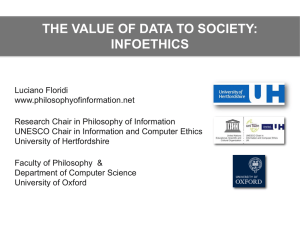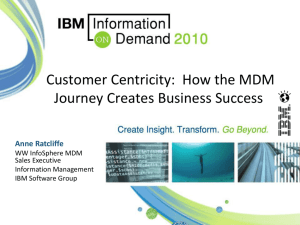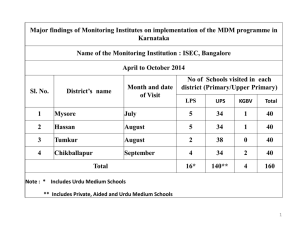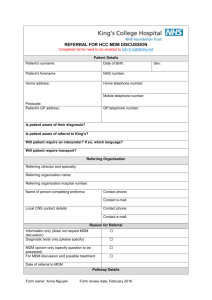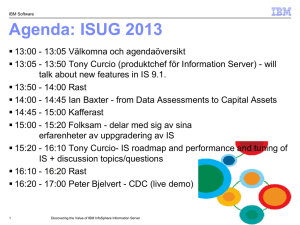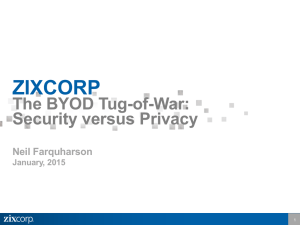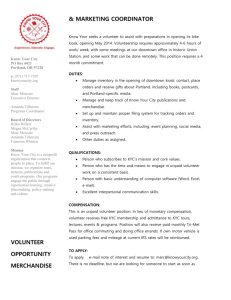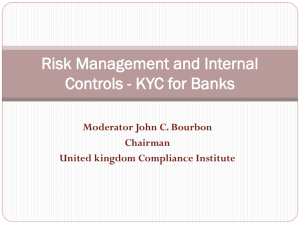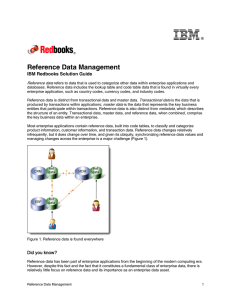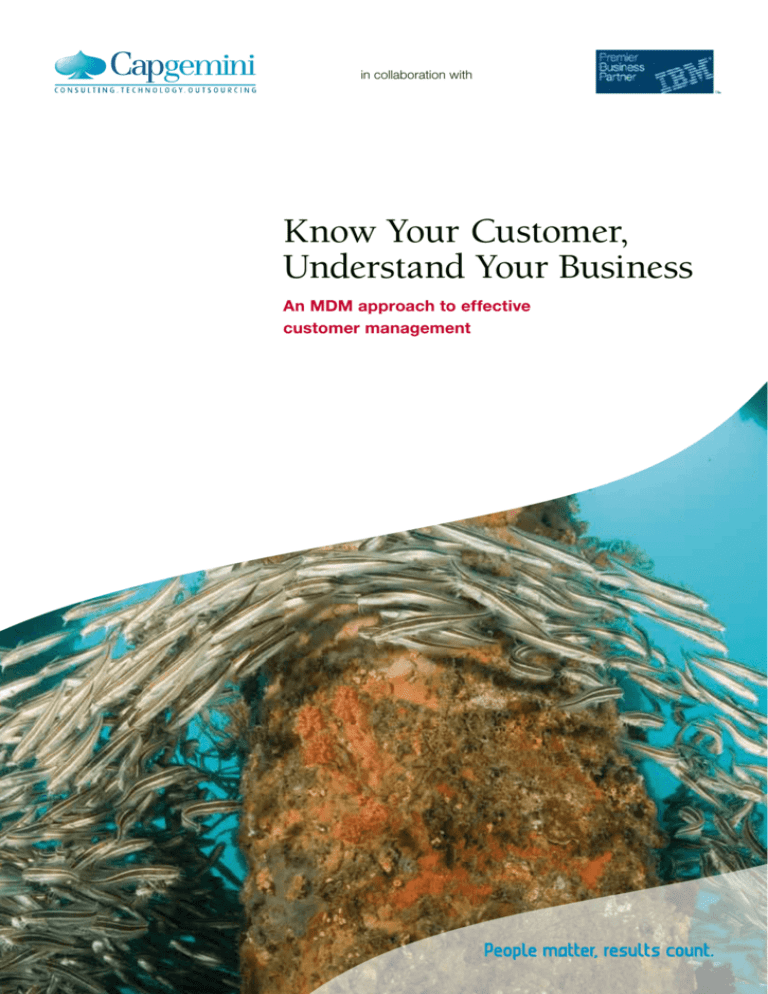
in collaboration with
Know Your Customer,
Understand Your Business
An MDM approach to effective
customer management
MDM Information Landscape
MDM information landscape
Sales &
marketing
Organisations
Customers
Individuals
Finance
ENTERPRISE
RISE
Manufacturing
anuf uring
anufactu
Master data
Mas
Supply chain
Logistics
Suppliers
Partners
Research
organisations
Contr
Contract
manu
manufacturers
Industry & Regulation
Legends
Information flow of transactional information and events
Translation via master data
Picture this: A parent goes online to
order a laptop for her college-bound
daughter. After an hour, she finds the
process of configuring and ordering
her system to be confusing and
frustrating. In desperation, she calls
the company hoping to have better
luck with an actual human being.
The sales rep on the phone receives
an alert that the caller isn’t just
another confused web-user; this
working mother is the purchasing
executive for a large insurance
company who currently buys more
than $10m dollars in computer
equipment from them each year.
Instantly the system flags the parent
as a “platinum” customer, presents
a new set of available discounts and
flags up the daughter automatically
as a “gold” customer as a result
of her influence relationship. The
product configured on the website
is automatically pulled up and a
series of clear recommendations
on alternatives is made. The parent
buys the laptop and is delighted
when her daughter informs her that
a month later she received an offer
via Facebook for some discount
educations software and checking
that she was happy with the laptop.
Know Your Customer, Understand Your Business
A follow-up call from the corporate
sales person enables the company to
expand its offerings to the client
and deliver a new managed service
for computer equipment based on
the level of customer service the
executive received.
This whole story, from its beginning
to its end, illustrates what can be done
when a company has comprehensive
visibility into their full relationship
with their customers. Too many
companies have increased costs from
flying blind in seemingly routine,
every day customer interactions.
Treating all customers as equal doesn’t
work so businesses have a choice:
Take control of the problem or leave
these decisions to simple chance?
If the opposite of this positive
scenario seems more likely, that’s
probably because it is. Lack of
customer visibility is so widely
prevalent in business processes
worldwide, the issue crops up in
some surprising places. For example:
A social services administrator of a
large urban county in Southern
California who finds out he’s been
sending checks to the family of a
beneficiary who has been dead for
three years
A money-center bank that finds
they’ve been paying six times over
for the same credit check for more
than 30 million consumer and
small business customers
A financial institution which loses
a major corporate client due to
aggressively chasing their CFO’s
spouse for a minor credit card
overspend during a major
corporate renegotiation
A foster care agency in the UK who
suspects that a child in their care
is a subject of abuse; but because
they can’t coordinate information
about this child with their
education and national health
service counterparts, the child dies
A consumer credit organization,
which, in attempting to increase
market share, saturates their
customers’ mailboxes with offers
and promotions, eventually
accounting for fully one third of
the bulk mail volume in the USA.
3
Information Technology has
largely failed to keep up with this
information challenge because most
information systems are purposebuilt to manage processes, but not
to manage data. IT makes it easier
to open a bank account, move your
medical records, change insurers,
apply for benefits, and pay taxes. But
for the most part, little is done to
ensure that duplicate representations
of the customer, patient or constituent
are not introduced through each
one of these interactions, perhaps
multiple times. Over time, a tolerance
for poor information quality
and reliability has an impact on
business performance as customers
are badly sold to, badly marketed
to and badly serviced due to an
inability to recognize and track them
through successive transactions.
Eventually, data duplication and
inaccuracy cumulates to a point
where organizations aren’t even sure
how many account holders, patients,
or taxpayers they really have, let
alone assess their exposure to credit
risks, understand the effectiveness
of medical procedures or anticipate
future demand for services.
“Know Your Customer”... not
just a good idea … it’s the Law.
As you might expect from an issue that
impacts public safety, not to mention
tax revenue, as much as customer
satisfaction, a growing number of
legislative and regulatory initiatives
have been introduced trying to deal
with poor quality customer data. A few
examples include:
The USA Patriot Act contains
provisions dealing with the
identification of new customers
(“CIP regulation”) in a
number of commercial and
government processes
Anti Money Laundering (e.g.
Bank Secrecy Act in USA) set up
to prevent fraud and money
laundering require organizations to
clearly identify customers within
high value transactions
OFAC – the Office of Foreign
Assets Control publishes lists of
individuals and organizations with
whom United States citizens and
permanent residents are prohibited
from doing business
Over time, a tolerance for poor information quality and
reliability has an impact on business performance as
customers are badly sold to, badly marketed to and
badly serviced due to an inability to recognize and track
them through successive transactions.
Basel II requires organizations to
maintain adequate capital reserves
link to exposure from a potential
default from individual or
commercial trading partners
Data Privacy legislation that
requires organizations to provide
all information held on an
individual and for consistent access
and marketing policies across a
whole group
FATF – the Financial Action Task
Force an intergovernmental body
sponsored by the G7, maintains
rules regarding conducting
commercial business with
Politically Exposed Persons
HIPAA – the Health Insurance
Portability and Accountability Act
specifies regulations regarding the
dissemination of patient
information, including medical
histories, subject to the expressed
permission of the patient.
For most financial institutions, indeed
any commercial enterprise that
conducts business internationally
with government, or deals
with medical, legal or financial
information, it is no longer an option
to institute and guarantee compliance
with these and other regulatory
regimes is no longer an option. It is a
pre-requisite to doing business at all.
Continuing struggles with an explosion of information
Increasing Complexity
Declining Quality
Protecting Privacy
Ensuring Compliance
1 trillion
$8.2 million
$204
$29.8 billion
Connected devices in
the world
Annual loss by average
organization due to poor
data quality
Cost per compromised
record
U.S spending on
governance, risk and
compliance
Figure 2: It’s not really news to say that we’re living through an explosion of information. The fact that this paper exists, and that
you’re reading, attests a general dissatisfaction with the results the tools, methodologies and paradigms available to deal with
this explosion.
Source: searchcompliance.techtarget.com
4
MDM information landscape
Sales data
Account data
Product data
Budget data
Purchase order
data
Materials master
data
Poor & inconsistent data entry
Marketing data
Pricing data
Inventory data
Forecast data
Vendor master Receipting
data
data
Limited to no cleansing of raw data
and inconsistencies in management
Disparate and multiple technical data repositories
Strategy
Planning
Reporting
Acceptance of limitations in the
status quo
Mid-long term direction
Responsive to circumstance
Monitor and tracking
Business management
Regulations such as these are often
broadly categorized under the
heading, “Know Your Customer”, or
“KYC” for short. It may sound like
a marketing catch-phrase, but KYC
has real teeth. Failure to comply
with these and other regulations
can result in financial and law
enforcement audits, fines and
prohibitions on doing business in
certain sectors or countries, even
jail for an organization’s executives
and officers.
Comply for compliance,
or comply for success
The choice on KYC is whether to
you look for the quickest way to
undertake compliance via back-office
reporting, or to look at the most
efficient way to balance compliance
with competitive advantage.
Compliance based purely on cost
means meeting the requirements of
the legislation, but not delivering
any of the operational benefits to
your own organization: in effect
the legislation becomes a tax on
operations. A much more effective
business strategy is to consider how
Know Your Customer, Understand Your Business
the business can operationally comply
with the legislation and thus not only
meet the legal requirements but also
gain the business advantage that a
uniquely identified customer base
will give. In other words, while you
may initiate a KYC program because
you have to, that doesn’t mean you
can’t use KYC to make money, lower
cost, or in short perform better as
a business.
How do you “Know Your
Customer”?
Unique identification is a
governance challenge. Unique
identification is something that
sounds simple; all you have to do is
ensure that every customer that you
deal with has only one record within
your systems. In order to do this
however you need an enterprise wide
understanding of the definitions of a
customer. Is it the same in all entities,
is a ‘prospect’ a customer or should
these be handled differently?
This agreement, by the business
on the information definition of a
customer, is essential as without it
none of the technical elements are
going to be based on operational
reality or agreed business practice.
Then the business must agree on
what constitutes a certain or probable
match. This is rarely based on a single
characteristic so a clear set of business
policies are required.
you need an
enterprise wide
understanding of
the definitions of
a customer.
The reality is that it is impossible to
get every decision right automatically
therefore it’s important to also decide
on the practice for resolving probable
matches within normal operations or
as an additional back-office process.
Setting the thresholds between certain
and probable is an on-going and
evolving exercise, not something that
is done once and left. These policies
should be enterprise-wide and not
considered optional based on channel
or local whim.
5
Automating the policies
So, as a practical matter, how do
you turn the “Know Your Customer”
policies into operational reality?
It seems reasonable to turn to
automation to try to solve at least the
customer identification dimension
of KYC problems. But automation in
itself creates its own challenges. For
example, your system will need to get
access to customer data across all the
systems and online data stores where
it resides. It will need to overcome
many common data discrepancies
(e.g. misspellings, transpositions, outof-date or missing data) commonly
introduced in systems that facilitate
customer interactions. And you’ll
at all times need to ensure that the
resulting, aggregated customer record
is correct and validated according
to standards your organization sets,
both for its internal and regulatory
compliance objectives.
Getting to Know You –
Identifying the customer
from the beginning
Given the volume and variety of
customer data typically maintained
across an enterprise’s IT systems,
automating customer identification
and data integration across these
systems is the only long term option.
It is also essential to start making
changes to those processes that
create and modify customer data,
to ensure the quality, reliability and
accuracy of customer information,
right at the point of interaction
where that information is acquired.
It is a good practice to integrate your
customer-facing and business process
applications with data management
and quality management controls,
such as “search before create” features
that eliminate data duplicates before
they’re created, or data quality and
validation features, such as physical
address and delivery point validation.
These features ensure that customer
data is accurate and valid at the time
it’s obtained, when a new account is
created for the customer, or when the
customer independently updates their
address information, for example.
It is a good practice
to integrate your
customer-facing
and business
process applications
with data management
and quality
management controls.
Information Governance: Unified process ensures enterprise Success
Define Business
Problem
Obtain Executive
Sponsorship
Conduct Maturity
Assessment
Build Roadmap
Establish
Organization
Blueprint
Build Data
Dictionary
Understand
Data
Create Metadata
Repository
Define Metrics
Appoint Data
Stewards
Create
Specialized
Centers of
Excellence (COE)
Implement Master
Data Management
Manage Data
Quality
Manage
Security &
Privacy
Manage
Life-cycle
Measure
Results
Enable through Process
Enable through Technology
Figure 4: IBM® recommends orchestrating business priorities and IT execution through a cohesive Unified Information Governance
Process, to ensure the important needs of stakeholders are understood and met, and that multiple technology initiatives can
support each other towards a concerted goal.explosion.
6
Name:
What is Master Data Management?
Address:
IBM provides a cost-effective, rapidly deployable solution to complex customer data management challenges
SOURCE SYSTEMS
MASTER DATA MANAGEMENT
SALES
CRM
Name:
Address:
INFORMATION
B Jones
35 West 15th Street
Toledo, OH 12345
ERP
Name:
Address:
William Jones
35 West 15th Street
Toledo, OH 12345
Legacy
Name:
Address:
Name:
ENTERPRISE APPLICATIONS
Address:
Billie Jones
36 West 15th St
First:
Bill
Last:
Jones
Address:
35 West 15th Street
City:
Toledo
State/Zip:
OH 12345
Gender:
M
Age
50
DOB:
01/01/65
CUSTOMER SUPPORT
CLAIMS
Toledo, OH 12345
Figure 5: Whether it’s a prospect creating a new account, a customer calling the help line, or a patient checking into the hospital,
MDM helps connect the different pieces of information about you from all of an organization’s systems so that they can have a more
complete view of who you are, understand your total value to them, provide better service to you and reduce their operational costs.
IBM® InfoSphere™ has invested
heavily in the infrastructure needed
to integrate customer-facing “last
mile” applications and systems
with common capabilities for data
integration, reconciliation, validation,
standardization and enrichment. One
example where this infrastructure has
been leveraged quite successfully is
in MDM-Powered business solutions
for hosted CRM applications. In
these solutions, IBM has mustered
a number of different MDM,
data integration and data quality
technologies into a set of services that
ensures the accuracy of data about
customers, partners and prospects,
as well as the associated contacts
for customer organizations. Using a
Service-Oriented Architecture (SOA)
approach, increasingly common in
enterprise data integration, allows
for these services to be plugged
directly into Software-as-a-Service
(SaaS) applications, and for these
applications’ data to be directly
integrated with data from more
conventional back-office systems.
In these solutions,
IBM has mustered
a number of
different MDM, data
integration and data
quality technologies
into a set of services
that ensures the
accuracy of data
about customers.
Enter New Account
Search for Duplicates
Continue to Create Account
Account Name: UPMC
Address Dr.
Street
City
200 W Madison
Chicago
200 W Madison St
Chicago
State
Zip
Country
Correct
IL
60606
USA
Correct
IBM InfoSphere MDM integration into hosted CRM applications, allowing for incoming customer data to be de-duplicated, validated and
standardized before it’s introduced.
Know Your Customer, Understand Your Business
7
Master data services are plugged
directly into the CRM user
experience, ensuring, for example,
that redundant customer and contact
information is scrubbed, that address
and other information about those
customers is valid, that augmentation
and enrichment with third party
information needed for KYC
initiatives is available.
IBM’s MDM Powered business
solutions for hosted CRM applications
demonstrate how a complete package
of data management systems and
services support a specific business
goal, ensuring accuracy and relevancy
of data used in common customer
interactions supported by a packaged
applications, like CRM. This business
solution is made of a number of
technical components, harnessed
using a common methodology. But
how does this methodology, and the
role prescribed by it for each of the
supporting technologies, work in a
complex and dynamic enterprise IT
environment to solve a number of
different KYC problems?
How do you know what
you know?
Most of us don’t have the benefit of
starting from scratch. We’re trying to
improve the reliability of customer
information as that information is
being updated, as new customers are
being on-boarded, in real-time, and
reconciling that information against
the large volume of existing customer
data that was previously obtained,
often without quality, reliability or
governance controls. Shutting down
core business processes that service
your customers, and just cleanse
and validate this data is simply
not possible.
An important step is to start by
getting a handle on the scope of
your customer data problem. Your
existing customer-facing systems
and applications contain lots of data,
and it’s good practice to want to put
that data under a microscope, to
scan, analyze, profile and report on
the completeness of that data, how
consistent it is within and across
systems and how that data checks
out against external reference sources
your organization and others trust.
This should serve as a baseline against
which future improvements can be
assessed. You should use this baseline
to determine what your priorities
should be, which systems are most
relied upon, which have the biggest
and most pervasive problems, and
what quality targets you should set for
those systems.
By undertaking these steps, you
not only gain an awareness of the
customer identification challenge,
you also communicate that problem
more broadly, in terms that executives
and line-of-business leaders who
own customer relationships can
readily consume. You also provide
the basis by which efforts to mitigate
this problem will be understood
and judged over time, and how the
value of those efforts to the broader
organization will ultimately
be perceived.
IBM InfoSphere Discovery provides
a key set of capabilities supporting
the analysis, correlation and
reconciliation of diverse sets of
customer information, across business
processes and applications. Its unique
and powerful capabilities enables
organizations to automatically
describe and document all available
customer data sources, identify and
cross-reference proprietary systems
for classification and qualification
of customers and develop rules for
mapping and reconciling that diverse
data. Discovery is instrumental
in determining where data is
located and how it’s linked across
systems, intelligently capturing
relationships and determining applied
transformations and business rules
to deliver a complete customer view.
Discovery, when used in conjunction
with InfoSphere data analysis, and
data cleansing tools, provides a
comprehensive platform for the
discovery, profiling, qualification
and reporting on any organization’s
information about its customers.
Its unique and powerful
capabilities enables
organizations to
automatically describe
and document all available
customer data sources,
Major Asia Pacific Bank
A large multi-service bank with several distinct retail brands needed to move from
over 70 current customer masters and many different customer management
processes down to one standardized approach in order to comply with anti-money
laundering, fraud and deposit protection legislation. This also had the benefit of
significantly reducing cross brand cannibalization of customers and increasing the
accuracy and success of marketing campaigns.
8
Somebody’s got to clean
up this mess
Fixing the processes and analyzing the
data is great, it gives you a real ability
over time to incrementally improve
your customer information so going
forward the organization will be able
to improve and sustain that quality.
Unfortunately this doesn’t address
the other challenge, all of the existing
systems and the data within them
which fails to meet the corporate or
legal requirements.
Because you’ve taken the trouble to
analyze and profile your customer
data before hand, you know what the
most common data issues are, where
the duplication and overlap is, and
which systems and business processes
are most prone to introduce errors
that prevent you from knowing your
customer. It allows you to set up your
data integration, data quality and
master data management platforms
with rules and exception processes to
dynamically flag and correct the most
common data issues you’re likely to
encounter in customer data.
in even the most distributed
and technically diverse IT
environments, and delivering the
information that comprises actual
customer knowledge.
Automation may correct 99% of the
issues preventing you from correctly
identifying your customers, and
that’s great. If you’re dealing with
10, 50 or 100 million customer
records, though, that still leaves
unresolved discrepancies and
unknowns in significant numbers.
For these, more opaque, harder to
resolve data issues, you can turn to
offline processes for data research,
remediation and cleansing for
resolution. These processes, which
are equivalent to processes used
by some of the most trusted names
in reference data, like Dunn &
Bradstreet and Acxiom, will get your
customer data to a state of “5-9’s”
quality and reliability.
“Know Your Customer”,
Understand your business
Having a high level of quality of
customer information is not a goal in
itself, ultimately you’ll want to leverage
the automation you’ve introduced to
cleanse, validate, enrich and match
your customer data, across systems and
sources, to obtain that single customer
view, to help your business recognize
and anticipate the needs of your
customers. To do this, you’ll want to
introduce features into your customerfacing systems that allow your line-ofbusiness users, the sales people using
CRM, the support reps using your
trouble ticketing system and the people
executing your fulfillment processes.
These users will leverage these features
to get real-time access to accurate and
relevant customer information they
need to serve your customers better,
cross-sell and up-sell them better,
understand and anticipate their needs
more effectively.
IBM InfoSphere Information Server is
the premier data integration, analysis
and data quality platform, used every
day by the Global 2000 to ensure the
completeness, accuracy and reliability
of their customer information.
Using Information Server, these
companies automate acquisition of
information across online data stores
and business process applications,
transform, validate and consolidate
that information into centralized,
structured repositories, and make that
information available to important
stakeholders both within and outside
their organizations. Information
Server incorporates insights acquired
previously from Discovery, data
profiling and analysis, and can
support data cleansing, augmentation
and enrichment prescribed by those
analyses in its data acquisition
processes, both in batch and realtime. In terms of acquiring customer
data in support of KYC initiatives,
Information Server can be thought of
as a great equalizer, overcoming the
most challenging integration obstacles
Know Your Customer, Understand Your Business
9
IBM InfoSphere MDM provides the
platform for turning diverse, distributed
customer information into a centralized,
reliable store of customer knowledge,
and making that information available
to diverse audiences involved in KYC
and other business initiatives. MDM
accomplishes this by first acquiring
data, then by leveraging other
InfoSphere tools, like Information Server
and Discovery, and converting that data
into information that conforms to the
established standards and practices of
the enterprise. For example, MDM will
ensure that information pertaining to
customer and prospect identity will
be available and complete, even for
Industrial Telecommunication Insurance
Energy &
Utilities
atio
n
ed
rty
Pa
ag
Pack
Data
rvic
e
D at
Crea a
tion
r
lie
p
p
Su
el
s & Data Mod
Data
Maintenance
Data
izable
Data
Domains
stom
L oc
Product
Asset
nt
o u nt
ccccou
AA
Se
Hi Tech
Manufacture
Master Data Ma
na
ge
m
e
Others
Co
Au llab
th ora
or tiv
ing e
Retail
Financial
Services
nt
p
oS
f
In
e
he r
Energy &
Utilities
Cu
Government
er
y
Healthcare
complex business customers. MDM
can ensure that additional information
required for compliance purposes,
such as OFAC checklist, credit reports
and other dimensions of what it means
to “Know Your Customer” are included
in the central master record. Finally,
MDM can make this information
available to authorized consumers
in business processes where the
information is needed, through a
robust library of Web services that
easily plugs into other application
runtimes. MDM provides that “last
mile” of capability that not only turns
customer information into recognized
knowledge, but makes that knowledge
liv
De
p
shi
ard
Stew
Analytics
Figure 7: IBM InfoSphere Master Data Management addresses a wide set of business
requirements across all industries. It enhances master data with unstructured
information and analytics to support broader use, deploys flexibly with options &
implementation styles suitable for any IT environment, allowing organizations to
quickly master their most important enterprise data assets, while executing towards a
long-term strategic vision.
10
widely available to the constituencies that
need it, turning “Know Your Customer”
into a practical, day-to-day reality.
Making it work – How to
automate understanding
Making these capabilities available
to line users of your customer-facing
systems is where the organization turns
compliance to its own advantage. It is
here where IT finally allows you to know
your customer at the actual point of
interaction where you’re doing business
with them. But for most enterprises,
customer-facing systems have complex
architectures, are geographically
distributed and may have distinct
differences across business lines.
A successful KYC initiative should deliver
this value rather than simply the costs of
high quality information. Your customer
master data platform must come equipped
with the services and interfaces needed to
plug into customer facing systems, allow
for rapid search and look up, enforce data
quality, augmentation and enrichment
rules, and validate incoming customer
data according to both enterprise and
industry norms and standards. Doing so
will allow the marketing, selling, fulfilling
and servicing functions to operate in a
cohesive manner that keeps the customer
attached to your brand.
IBM has a strong track record of helping
global organizations leverage InfoSphere
technologies in support of automating
acquisition, synthesis and delivery of
organizational knowledge about their
customers. The KYC goals to which
accurate, relevant and trusted customer
knowledge can be applied are as diverse
and varied as customer information itself.
But one common theme running through
each of these goals is the potential value
they yield to the organization willing to
invest in infrastructure necessary to get
beyond simple compliance. InfoSphere
software is a critical component for that
infrastructure for most of the Global
2000. Perhaps that’s why InfoSphere
software is recognized by Gartner
Research as a leader in virtually every
enterprise software category that’s
required to support KYC initiatives,
including data integration, data quality,
MDM, business intelligence and others.
MANAGE
DB2, Informix
FileNet
INTEGRATE
ANALYZE
InfoSphere
Information Server
InfoSphere BigInsights
InfoSphere
Warehouse
solidDB
External
Information
Sources
Cognos,
InfoSphere
Warehouse
InfoSphere
MDM
Business
Analytic
Applications
GOVERN
Quality
Lifecycle
InfoSphere Informtion
Server
InfoSphere
InfoSphere
Streams
Security & Privacy
InfoSphere
Figure 8: IBM Information Management views organization’s ability to synthesize raw data into actionable knowledge through the
metaphor of an “Information Supply Chain”, one that runs in parallel, and within, the organization’s most important business processes.
Sustainable quality over time
To deliver KYC therefore requires:
Clearly define what KYC means for
your business and set up the required
governance, policy and standards
The identification and prioritization
of KYC problems confronting your
organization and the expected ROI
from solving them
Undertake data analysis, profiling
and reporting tools to get a
quantifiable handle on the customer
data issues your organization will
need to resolve to meet your
KYC goals
Introduce automation into your
customer facing processes to
eliminate 99% of the most typical
issues affecting the quality of your
customer information
Leverage offline remediation services
to obtain a “5-9’s” level of customer
data quality and integrity
Introduce master data features into
the customer-facing business
processes to ensure that only high
quality, accurate and reliable
customer information is used in
those processes
Leverage master data services in your
distributed enterprise architecture to
ensure that high quality customer
information is universally available
and widely leveraged
US Retailer
A major US retailer has embarked on the Single View of Customer (SVoC)
initiative to provide customers with more efficient service, more informed product
recommendations and more value-added services like in-home and multi-channel
sales opportunities and greater visibility across the lifecycle of their order, thereby
improving their experience and their engagement with the retailer. The current
solution took over three days to cleanse customer information and this was never
fed back into core operational systems.
Know Your Customer, Understand Your Business
Leverage data quality analysis and
reporting to quantify
improvements in your customer
data, as these new capabilities are
being rolled out.
Conclusion
How do you get started? We
encourage you to take a closer look
at Capgemini’s business driven
MDM approach to solving your
most prominent KYC challenges,
an approach we’ve taken into a
number of clients worldwide across
a broad spectrum of industries.
When coupled with IBM InfoSphere’s
industry leading technologies
Master Data Management, Data
Integration and Data Quality,
these methodologies will allow
you to better take advantage of the
“carrots” represented by KYC to
further understand and anticipate
the performance of your business,
all whilst avoiding the KYC “sticks”.
We believe that the track record of
Capgemini working in collaboration
with IBM will provide you with
a strong and effective capacity to
leverage your customer information
to better understand your business.
11
www.capgemini.com/
About Capgemini and the
Collaborative Business Experience
Capgemini, one of the
world’s foremost providers
of consulting, technology and outsourcing
services, enables its clients to transform
and perform through technologies.
Capgemini provides its clients with
insights and capabilities that boost their
freedom to achieve superior results
through a unique way of working, the
Collaborative Business Experience™.
The Group relies on its global delivery
model called Rightshore®, which aims
to get the right balance of the best
talent from multiple locations, working
as one team to create and deliver the
optimum solution for clients. Present
in more than 35 countries, Capgemini
reported 2009 global revenues of EUR
8.4 billion and employs over 100,000
people worldwide.
More information about our services,
offices and research is available at
www.capgemini.com
Capgemini
IBM
Steve Jones
Global MDM Lead
Business Information Management
London, UK
Ian T. Stahl
IBM Software group, Information Management
Director of Product Management
Austin, Texas, USA
©2011 Capgemini. All Rights Reserved. No part of this document may be modified, deleted or
expanded by any process or means without prior written permission from Capgemini. Rightshore ®
is a trademark belonging to Capgemini.
IBM® and IBM InfoSphere™ are trademarks of International Business Machines Corporation,
registered in many jurisdictions worldwide.
Reference; Helvetica Neue 55 Roman; 7/9 pts.
To learn more about Capgemini and IBM solutions that help you to better Know Your Customer
please visit the Information Governance website on the topic or contact bim@capgemini.com

